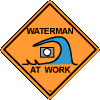
Building PVC Kayak Carts
Kayak Cradle Dolly
This is how to make a simple cradle dolly that will work with just about any kayak. If you must transport more than one type of kayak, a cradle dolly is a better choice than a scupper dolly.

This kayak is hauled across some pretty tough terrain, including steep, sandy hills, deep sand beaches and wet rocks so it is built for heavy duty hauling with 1 1/2" PVC pipe and pipe fittings as well as pneumatic tires. All the materials can be purchased at any home improvement store like Home Depot. The 10" pneumatic tires can be purchased at Harbor Freight, there are more expensive balloon tires that can also be used.
This is how to make a simple cradle dolly that will work with just about any kayak. If you must transport more than one type of kayak, a cradle dolly is a better choice than a scupper dolly.

This kayak is hauled across some pretty tough terrain, including steep, sandy hills, deep sand beaches and wet rocks so it is built for heavy duty hauling with 1 1/2" PVC pipe and pipe fittings as well as pneumatic tires. All the materials can be purchased at any home improvement store like Home Depot. The 10" pneumatic tires can be purchased at Harbor Freight, there are more expensive balloon tires that can also be used.
Construction is pretty straightforward using 1 1/2" PVC pipe and fittings. Cut the pipe pieces and fit them together before you start gluing. This cart is built a little higher than some so the kayak can be hauled up steep hills without the hull hitting the ground.
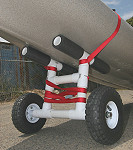
When you have the PVC frame assembled, make the axle using a 5/8" threaded rod, four flat washers for strength, two 5/8" hex nuts to use as stop nuts inside the PVC pipe and two 5/8" stainless steel lock nuts to hold the wheels on. Click HERE to see a detailed drawing on how to fit the 5/8" axle into the PVC frame. Use plugs on the ends of the open PVC pipes so water will not get inside and rust the axle, washers and nuts.

When you have the PVC frame assembled, make the axle using a 5/8" threaded rod, four flat washers for strength, two 5/8" hex nuts to use as stop nuts inside the PVC pipe and two 5/8" stainless steel lock nuts to hold the wheels on. Click HERE to see a detailed drawing on how to fit the 5/8" axle into the PVC frame. Use plugs on the ends of the open PVC pipes so water will not get inside and rust the axle, washers and nuts.
Because the cart is used to haul a fully loaded kayak over rough terrain, there are two straps to hold the kayak on the cart. Most of the time, one strap is enough to secure the boat, but in sketchy situations, it's better to be safe than sorry, so a second strap is there for added security.
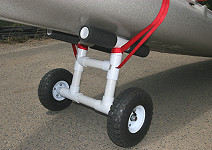
These straps come in sets of two, so might as well use them both. One strap is sewn around the PVC tubes under the hull cradle pipes. Use 10lb. test monofilament fishing line and plenty of stitches because this strap is under a lot of stress when the strap is tightened around the hull.

These straps come in sets of two, so might as well use them both. One strap is sewn around the PVC tubes under the hull cradle pipes. Use 10lb. test monofilament fishing line and plenty of stitches because this strap is under a lot of stress when the strap is tightened around the hull.
 The second strap is threaded though the dolly crossmember. Before gluing the PVC "tee" fittings on the cart, cut a slot in each one so you can thread the strap through. It's easiest to thread the strap though before gluing the top hull cradle PVC pipes and fittings on, but if you forget, you can thread it though when the cart is assembled, it's just a little more tricky. When the second strap is not used, wrap it around the cart.
The second strap is threaded though the dolly crossmember. Before gluing the PVC "tee" fittings on the cart, cut a slot in each one so you can thread the strap through. It's easiest to thread the strap though before gluing the top hull cradle PVC pipes and fittings on, but if you forget, you can thread it though when the cart is assembled, it's just a little more tricky. When the second strap is not used, wrap it around the cart.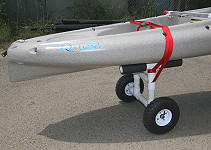
Glue some end plugs in the hull cradle PVC pipes to keep water out , slide some pipe insulation on and the cart is ready to go.
This is a scupper dolly for a Hobie kayak made from 1 1/2" PVC pipe and pipe fittings and pneumatic tires. This cart fits into the scuppers of the kayak.
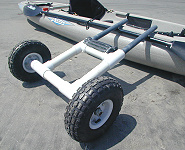
Since I have to haul my kayak across deep sand and rocks as well as up sandy hills, I needed pneumatic tires instead of hard rubber tires. A 5/8" threaded rod is used as the axle for the 10" pneumatic tires that I bought at Harbor Freight. Click HERE to see a detailed drawing of how to fit the axle into the PVC frame.

Since I have to haul my kayak across deep sand and rocks as well as up sandy hills, I needed pneumatic tires instead of hard rubber tires. A 5/8" threaded rod is used as the axle for the 10" pneumatic tires that I bought at Harbor Freight. Click HERE to see a detailed drawing of how to fit the axle into the PVC frame.
The two PVC pipes on the top of the dolly slide into the scupper holes in the hull. The outside diameter of the PVC tubes that go through the scupper holes is 1 5/16", which is about the same as the inside diameter of the scupper holes.
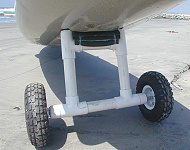
This prevents damage to the scupper hole on the inside of the hull that can be caused by thin metal tubing of some kayak dollies. The hull rests on the upper crossmember of the dolly. Since the hull is round, there is some foam insulation, held in place by zip ties, so the kayak rests securely on the dolly. It is easy for one person to lift the hull onto the dolly and when the hull is lifted up, the dolly slides out.

This prevents damage to the scupper hole on the inside of the hull that can be caused by thin metal tubing of some kayak dollies. The hull rests on the upper crossmember of the dolly. Since the hull is round, there is some foam insulation, held in place by zip ties, so the kayak rests securely on the dolly. It is easy for one person to lift the hull onto the dolly and when the hull is lifted up, the dolly slides out.
Here is the dolly and kayak ready to roll. The gray PVC pipes are through the scupper holes and stick up through the deck of the kayak.

By extending above the deck, there can be no damage to the inside of the scupper holes that might happen with scupper dollies whose thin metal tubes do not extend past the deck . Also, the dolly will not detach itself from the kayak unless it is lifted off of it.

By extending above the deck, there can be no damage to the inside of the scupper holes that might happen with scupper dollies whose thin metal tubes do not extend past the deck . Also, the dolly will not detach itself from the kayak unless it is lifted off of it.
The kayak sits on the dolly a little higher off the ground than standard kayak dollies.
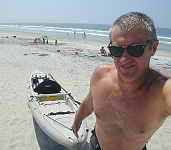
This makes it easier to pull the kayak up hills and inclined docks so the kayak does not hit the ground.

This makes it easier to pull the kayak up hills and inclined docks so the kayak does not hit the ground.
Back to the Kayak Rigging Page
Back to the Kayak Fishing Page
watermanatwork Home Page
Waterman At Work Blog
Contact Us
Back to the Kayak Fishing Page
watermanatwork Home Page
Waterman At Work Blog
Contact Us
All material on this website is the property of the owner and may not be used without permission.
© watermanatwork.com